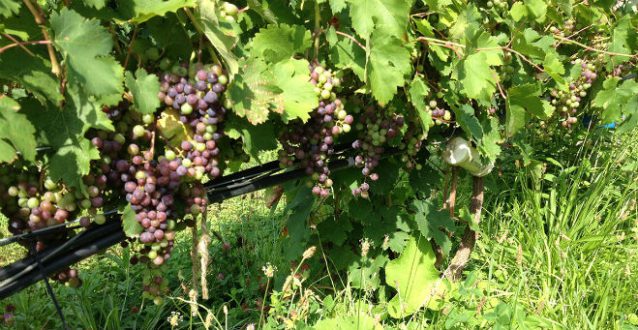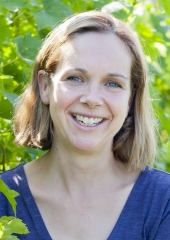

Jul 7, 2022Cornell’s precision viticulture research – from soil to canopy
Researchers at Cornell University’s School of Integrative Plant Science are addressing vineyard variability challenges with new digital agriculture solutions.
They are bringing engineers into the vineyard to develop and test various soil, canopy and crop sensors; working with software specialists to map and integrate spatial vineyard information; and using variable-rate technology for precision vineyard management.
Cornell sponsored a webcast in June that featured Justine Vanden Heuvel, professor in Cornell’s School of Integrative Plant Science; and Terry Bates, a senior research associate who runs Cornell’s Lake Erie Research and Extension Lab in Portland, New York. In the session, moderated by eCornell’s Christopher Wofford, the researchers described how precision viticulture offers a new set of tools for producers to target yield, quality and sustainability goals.
Originally funded through the U.S. Department of Agriculture/National Institute of Food and Agriculture/ Specialty Crop Research Initiative, a key element of Cornell’s involvement is participation in the Efficient Vineyard (EV) project. The national effort is designed to advance the use of precision viticulture in wine, juice and table grape production. The disciplines of engineering, precision agriculture, viticulture and economics are blended to measure vineyard soil, canopy and crop characteristics, model spatial data for viticulture information and manage vineyard crop load through variable-rate machine applications.
“We’ve had some of this data available for years but it’s been too pricey for small growers,” she said. “Now we’re seeing a lot more emphasis on how we use free satellites or smartphones or data that you collect on your own and put in your smartphone. This data should be available to growers all over. We’ve just got to make sure there’s not an economic barrier to that.”
Traditional grape production relies on sharp-eyed growers walking through the vineyards to check on vines and plant health.
“Digital viticulture is using a wide range of technologies that help us figure out what exactly is going on in the vineyard, and then using that information to guide some of our practices so that they are more efficient and more sustainable,” Vanden Heuvel said.


“Precision viticulture is about collecting spatial data in the vineyard from various sources and then processing that data into viticulture information that’s meaningful to growers and that they can make decisions on and then applying variable rate management in the vineyard by various techniques,” Bates said. “(These could include) manually or by making variable rate machines to do work in the vineyard.
“The My Efficient Vineyard (EV) software is an important part of that because it’s how we access and work with our grower groups in accessing data and working with them on making management decisions,” he said. “Anyone who is interested in just getting started with digital viticulture, all you need is a cell phone and the GPS that is on your cell phone, plus the My EV app, where you can go out and collect your own spatial data using the data collector in the software, and be able to map it and be able to see the variation in your own vineyard.”
Growers can find more information and sign up for the free My EV app at efficientvineyard.com. Bates said the application can be used for other specialty and row crops, as well.
A regional benefit
Vanden Heuvel said EV can be particularly beneficial to New York grape growers.


In California, where most of the vines are irrigated, they can turn the water on or off and they can control the vine size, she said. In New York, the water is mostly “on,” but when there’s a drought year like 2016, it’s “really off.”
“That’s a difficult thing for growers because we have a whole lot of vegetative material that we try to deal with,” she said. “That means our soil is going to have a significant impact based on our water-holding capacity and organic matter. That gives us some variability in our vineyards that we need to work around.
Addressing variabilities
Researchers look at the vineyard soil, plus canopy and crop characteristics.
New York has a lot of variability in its soil, he said: the Finger Lakes region has soils formed by glaciers, the Lake Erie region has soil created by the Great Lakes, with changing ridges of soil moving away from the Lakes. There are numerous other variables, he said.
“Water nutrient availability changes within feet in a vineyard. That will change vine size,” Bates said. “Light interception, which we try to capture with sensors, and the whole idea of trying to estimate the crop using sensors in the vineyard. All of those things vary. We try to put it together to do our variable rate management.”
“Our approach to precision viticulture is determining how you want to manage that variability,” Bates said. “Currently, most growers just have a block. They kind of shoot for the mean of that block and they have one management strategy giving them uniform management in a non- uniform system.
“The future is how can we get down to vine-to-vine management using sensors and technology and robots, for which we’re not quite there yet,” he said. “We focus on zones or management classifications. We take that data and try to create management classifications.”
Vanden Heuvel stressed the importance of this type of technology in the grape-growing and wine- making process.
“We absolutely need it,” she said. “All of these technologies are going to help in terms of environmental sustainability.”
Vanden Heuvel pointed to the work of Cornell’s Katie Gold, assistant professor of grape pathology, who has researched hyperspectral sensing of diseases.
“Instead of just spraying when you see a disease that’s already taken hold in the vine, you have an alert and you spray earlier and determine whether you’re going to spray or not based on this hyperspectral sensing of the vine,” Vanden Heuvel said. “Then, people are only spraying when they need to instead of spraying more often. There’s probably a hundred other examples I could give where it would really help environmental sustainability.
The Cornell team concentrates on readily accessible technology.
“We’ve been using cell phone images,” she said. “We use it for cluster counting and for the shoot tips, as well. (For) the cluster numbers. The cluster number is the biggest factor when we’re predicting yield.”
“From a production standpoint, if you go back to the 1940s, a lot of our vineyards were planted with a horse,” Bates said. “They overapplied fertilizers in the 1950s and used pretty bad chemicals in the 1960s. What we’re striving for in today’s vineyards are safety and efficiency. Our vineyards are more productive now than ever. Our fruit quality is better than ever. There’s a big push toward environmental sustainability, protection of the farm workers so that they’re not exposed to anything harmful and then to have a safe food product for our consumers.
“All of that revolution only occurs because growers accept and adopt science and technology,” Bates said. “Precision viticulture is just the next step in that.”
– Gary Pullano, FGN senior correspondent














